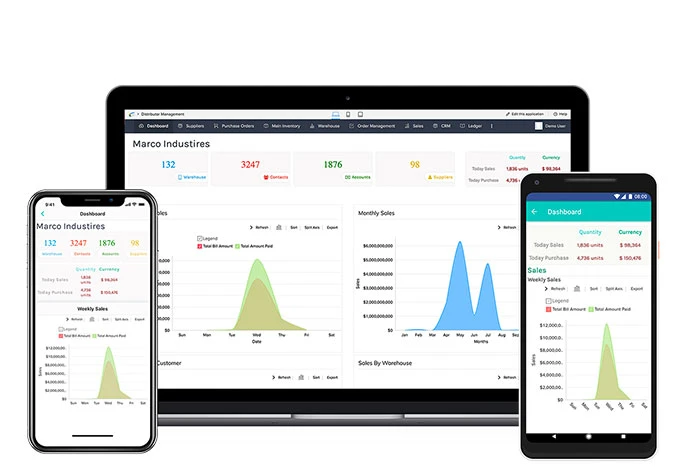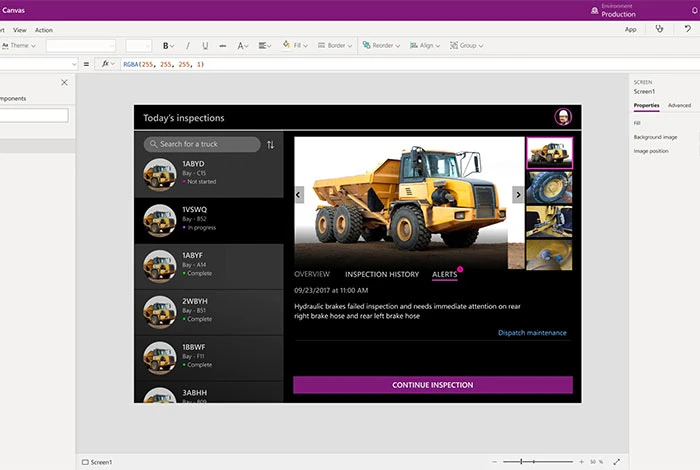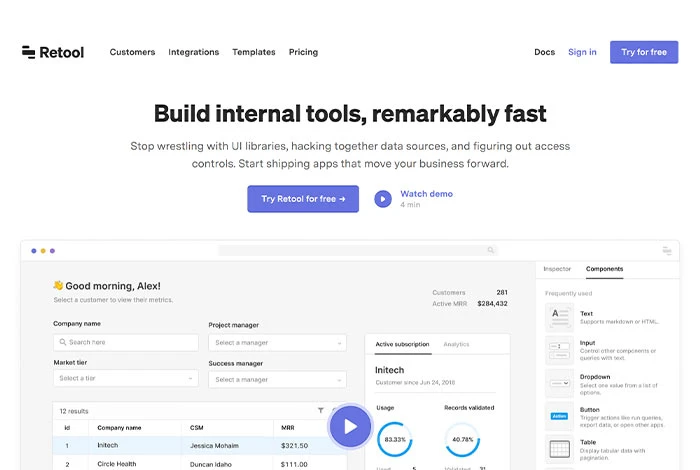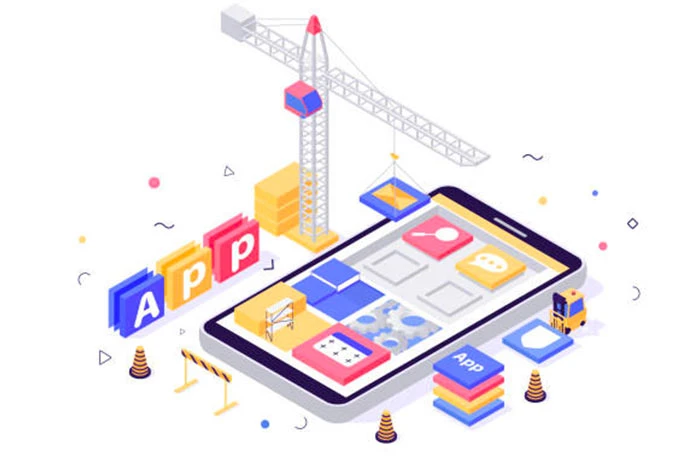10 Best Low Code No Code Platforms to Kick Start Your Startup

Gone are the days when you needed to spend huge amounts of money and wait for days/months or hire professional developers to build apps. Well, thanks to the advancement in technology. Now, you don’t necessarily need to be a coding expert or have knowledge of coding to build great applications.
Developing applications have become easier with low code no code platforms. What’s the best part? Low code or no code applications ensure that you write little to no code and still develop innovative apps that drive your business growth. Apart from that, these apps also ensure workflow automation, and provide other functionality to enhance your business processes.
Hence, businesses that are looking to scale new heights must look for unique solutions to enhance their productivity. Low code platforms might be a great solution in this regard. To learn more about the best LCNC platforms, read on!
What Does Low Code/No Code Platforms Mean?
Low Code/No Code Platforms are tools that allow non-technical users to create their own software applications without having to write complex codes. The adoption of this alternative app development method gives users the freedom to quickly build applications without the need of writing codes line by line. Hence, it provides greater user accessibility which in turn promotes innovation and reduces the burden of IT departments.
What’s the Need for Low Code and No Code Platforms?
Low code and no code development platforms provide an integrated development environment that helps business professionals and developers to conveniently drag and drop application components. They can then connect them together to create a responsive mobile or web app without having to do extensive research, write or test new scripts. Hence, no code low code platforms help professionals with limited or no knowledge of programming languages or coding to create applications easily.
Benefits of Low Code & No Code Platforms

According to a recent study, 84% of companies have turned to low code application development process to increase digital assets, reduce strain on IT departments and achieve greater agility. Given these figures, it is evident that companies must adopt digital transformation. Below, we’ll discuss the benefits of LCNC platforms.
- Faster Development
While traditional application development involved a skilled developer manually writing codes, low code no code platforms come with readymade templates that allow startups and small businesses to create custom made applications in no time.
- Limited Investment Requirement
Limited investment associated with low cost application development is one of the major benefits of LCNC platforms. It not only helps your business create responsive app in less time but also help you avoid hiring costs associated with professional developers who create custom made software manually.
- Improved Agility
We are living in a time where it is essential to respond quickly to changing opportunities and compliance issues. The simple interface of LCNC platforms enable companies to be more agile and experiment with new ideas without the need for external resources.
- Faster and Simpler Data Integration
Low code/ no code platforms allow quick integration with numerous services, thus, maintaining a uniform multichannel experience. It will allows the users to identify the source, validity, and also the quality of data in order to make informed decisions.
- Easy Support
Unlike manual coding process, users don’t need to read a code line to make changes in no code process. They can instead easily release an updated app by making changes with the visual interface.
Suggested Read: List of Best Code Review Tools for Developers
10 Best Low Code-No Code Platforms in 2025
Now that you know the benefits of low code and no code platforms, you might be thinking about investing in one for your business. The following platforms are some of the best available in the market for startups to SMBs.
Zoho Creator

Zoho Creator is a low code platform that allows users to build applications easily. No matter what level of coding experience you have, this tool makes everything quick and secure with its great collection of pre-built apps. It helps you design, develop and run any business software seamlessly by offering you customized solutions.
Zoho Creator Features:
- Real time reporting
- Automated workflow
- End to end encryption
- Easy drag and drop interface
- 24*7 support
- Custom dashboards
- Data import/export
Zoho Creator Pricing: Zoho Creator offers 15 days’ free trial. The professional plan starts @INR 1,000 per user per month that is billed per annum.
AppSheet
Google AppSheet is a no code app development platform that helps you build apps quickly with your existing data. It automatically generates app prototypes and provides quick suggestions for easy customization of the app. One of the highlighting features of AppSheet is that you can create bots to automate manual tasks. You can also create workflow logic and introduce machine learning models.
AppSheet Features:
- Accurate activity tracking
- Calendar management
- Automate workflows
- Integrate technology
- Access permissions
AppSheet Pricing: Test apps for up to 10 users by using features from any paid plan for free. The starter plan costs INR 397.31 per user per month. It includes basic application and automation features.
Appian
Appian is an integrated low code platform that helps build enterprise apps and achieve digital transformation. So, build highly intuitive apps faster with visual development without having to write all of the code from scratch. You can save costs up to 50 percent in app development with Appian. Start building your app today!
Appian Features:
- Intelligent automation
- Case engagement
- Unmatched security and compliance
- Quick app tools
- Dynamic reporting
Appian Pricing: Appian is available for free for 15 users. You can dive in and simply start creating apps. However, to get full access to the platform, you must purchase the application plan. The standard plan is priced at INR 5967.9 per user per month.
Microsoft Power Apps

With Microsoft Power Apps, everyone can quickly build and share professional low code apps the easy way. They offer prebuilt templates, easy drag and drop & many more advanced features, allowing you to start building apps quickly. Hence, Microsoft Power Apps can be a great platform for developers who don’t have technical knowledge for app development.
Microsoft Power Apps is equally useful for professional developers who can extend their app capabilities by including Azure Functions. It further supports custom connectors for on-premises or proprietary systems.
Microsoft Power Apps Features:
- Pre built templates
- Easy drag and drop designer
- Pre built AI components
- User friendly interface
- Model-driven apps
- Easy connectivity with cloud services
Power Apps Pricing: Microsoft Power Apps subscription plans start at INR 397.6 per user per app per month. It runs on one app and includes 250 AI builder service credits per month.
Suggested Read: Best Continuous Integration Tools (CI Tools) for DevOps (Updated List)
Outsystems
Outsystems is a feature-packed, low code software for enterprises of all sizes to develop any kind of application. This well-designed tool doesn’t let you lose control of your code and allows you to use it the way you like. Using Outsystems, you can build applications fast while, and at the same time, inspire transformation and innovation that could change the world.
Outsystem Features:
- Real time monitoring and reporting
- Scalable through APIs
- Quick mobile app deployment
- Access control and permission
- Multilingual support
Outsystem Pricing: OutSystems is available for free to develop an app for up to 100 users. The standard plan starts at INR 1,20,380.63 per month billed annually.
Mendix

Mendix is a popular low code development platform that helps develop applications fast. It helps you build solutions through workflow automation and focus on delivering the best user experience. Mendix aims to change the way developers build apps by incorporating the elements of scalability, speed and user experience.
Mendix Features:
- Intelligent automation
- Data integration
- Community support
- Multilanguage support
- Easy customization
Mendix Pricing: Mendix is available for free in which users get access to Mendix platform, templates, apps, free online academy and community support & more. The basic plan starts at INR 3995.51, which includes 5 users and access to log files, 9/5 support among other things.
Salesforce Lightning
Salesforce Lightning is one of the most powerful low code tools for companies to develop apps faster. The lightning platform allows businesses and IT professionals with limited or zero coding experience to create intelligent app experiences without building it from scratch.
Salesforce Lightning Features:
- Automate workflow process
- Scale your app with confidence
- Meet security and compliance regulations
- Easy drag and drop fields
- Personalized experiences for each user
Salesforce Lightning Pricing: The pricing starts at INR 1990.87 per user per month that is billed annually. Users get access to 10 custom objects, process automation, Lightning App builder & more.
Creatio
Creatio is one of the best low code and no code platforms where users can find multiple unique solutions such as premade templates to accelerate the app delivery process. Right from section structure to UI design, Creatio provides numerous options for customization and lets you build apps without writing a single line of code.
Creatio Features:
- Ready to use apps
- Out of the box solutions
- Customizable template options
- Pre-built connectors
- Machine learning and AI tools
- E-learning and corporate training
- Data management and analytic tools
Creatio Pricing: Creatio offers a free tool for unlimited users as process designer for collaborative process design with access to library, process documentation & more. The studio enterprise plan is priced at INR 1991.04 per user per month.
Retool

Retool is one of the best no code tools to create advanced apps with a graphical user interface. It makes it quick to build apps through its easy drag and drop features and other powerful building blocks such as charts, lists, forms & more. You can connect them to databases to build your own internal tools. In addition, with Retool you can import any library via URL and use them as and when you like.
Retool Features:
- Reliable and secure tool
- Integrate apps with other devices seamlessly
- Custom apps and dashboard
- Highly hackable
- Import any library and use them anywhere
Retool Pricing: Retool is available for free for unlimited users with access to all component types, advanced features, data sources and so on. The paid plan for teams starts at INR 796.32 per user per month. You can also check out the best retool alternatives.
Quixy
Quixy is a cost effective no code platform that empowers users with no code experience to build enterprise friendly apps conveniently. It is a cloud-based app that helps professionals who need digital solutions fast. Further, it helps automate, optimize and manage processes across the organization and create workflows.
Quixy Features:
- Business process management
- Create custom applications
- Travel and expense management
- Quick help desk support
Quixy Pricing: With Quixy, you can get a demo or free trial. The platform plan starts at INR 1593.23 per user per month. It allows you to create apps for a minimum of 20 users and is apt when the number of apps or workflows is high.
Suggested Read: Best Text Editors for Windows, Linux and Mac Coders
Examples of Low Code No Code Platforms
Despite being a new concept, low code or no code tools have revolutionized the way developers work. According to a study by Gartner, it is predicted that low code application building would gather over 65% of all app development functions by 2024.
Now, let’s look at a few examples of LCNC apps!
Examples of low code apps:
- Appian – Appian is a low code platform that is designed to help businesses of all sizes to build apps and automate workflows.
- Google AppSheet – Google Cloud’s AppSheet is a powerful no code application that can build and deploy apps in no time.
- Mendix – Mendix is among the few platforms that empower skilled developers to create both mobile and web apps at scale.
- Wix Editor X – Wix Editor X offers advanced designing solutions for professional designers. The platform combines responsive designs and layouts with its easy drag and drop functionality.
- Zoho Creator – Zoho Creator is another popular low code development platform that lets users create custom apps with limited to no coding experience.
Examples of no code apps:
- Creatio – Creatio’s no code solution lets users customize apps quickly as well as automate workflows without the need to write a single line of code.
- AppGyver – AppGyver is a leading no code platform that is designed for anyone looking to develop apps quickly for web or mobile use.
- Appy Pie – Appy Pie is a no code development software that lets you create mobile and web apps easily without learning to code.
- Nintex – Nintex offers easy to use low code development tools that allow users with little to no coding experience to create applications rapidly.
- Quickbase – Quickbase is a no code application development platform that can be customized further to create business solutions for your team to solve problems for every situation easily.
Solve your information troubles by gaining 360-degrees visibility into your projects, connecting your mission critical systems, and meeting all compliance requirements.
No Code Platform Vs Low Code Platforms: What’s the Difference

The main difference between low code and no code development platform is that low code is aimed at professionals with limited coding knowledge while no code targets business users who have good domain knowledge but lack the expertise to write code themselves. Hence, anyone can utilize no code platforms as no technical expertise is required.
Let’s have a look at some other feature differences between low code and no code.
| Point of comparison | Low Code | No Code |
| Training requirement | Appropriate for users with programming language | No technical experience required |
| App integration | Great system integration adaptability | May frequently fall short |
| Code modification | Developers can make changes to the code anytime | Closed system as it can operate on a single version of any app |
| Target audience | Developers | Anyone interested in app development |
| Security concerns | Low risk involved due to robust security processes | High risk as compared to low code platform |
Background or History of Low Code No Code Platforms
Low code/ no code has seen a rise in popularity in the recent years. While both the programming platforms have become more noticeable in recent times, they have a longer history.
The term “Low code” was coined in the year 2014 by Forrester to categorize development platforms that focused on ease of use and development simplicity. However, the exact low code trend started way back. To exactly answer who created LCNC programming platform would be difficult as it depends on exactly how you define these terms.
Nevertheless, let’s take a look at the brief history of low code development platforms.
- The development of LCNC platforms roots back to fourth generation programming language(4GL). (1970s to 1990s) The 4 GLs include support for multiple features like report generation, database management, automatic code generation and web development.
- In the 1990s, rapid application development (RAD) started gaining traction when ‘assemble’ desktop applications came in demand. All this development took place as a response to the Waterfall Model. It is a plan driven process that has been used by the software industry for quite some time now.
- In 2001, Model Driven Architecture (MDA) was launched by the Object Management Group. MDA lays down guidelines for software design as well as development and implementation.
- Fast forward to 2007, with the advent of mobile platforms, developers actively started using visual editors that run on Apple iPhone iOS and Android.
- The first use of the term Low Code became popular in 2016, after a publication by the Forrester Group.
- The low code term’s popularity has seen a boost in the year 2020. The Covid-19 pandemic came as a reality check for companies showing them how they lagged in terms of digitalization. Many businesses were forced to upgrade apps to keep the business operations going forward.
As per experts, the demand for low code/ no code development platforms will only continue to grow in the future.
Suggested Read: Best Free and Open-Source Web Design Software
Limitations of LCNC Platforms
For all the agility, scalability, and flexibility benefits of low code/no code platforms, there are a few limitations as well:
- Some functionalities might be difficult to implement on certain platforms
- Features like video/audio processing might not be supported on all LCNC platforms
- Designing an app on such platforms makes you dependent on third party technology providers. As a result, certain factors like price or service quality are beyond the control of founders
- Low code no code platforms without IT knowledge can create security risks
- While customization options vary from platform to platform, many LCNC platforms will limit your choices. Hence, it is important to evaluate your needs before you adopt any platform
- Some LCNC vendors lock you in the platform while others won’t allow you to edit apps once you stop using the tool. This makes it difficult for businesses to switch to a different platform.
Use Cases for No Code & Low Code Platforms
Check out the following user cases to see if LCNC platforms make sense for your business or not!
- UI design – It is no easy task to build a user friendly and appealing user interface. However, with low code tools, you can quickly generate code for a variety of platforms and devices including web, desktop and mobile.
- Quick integration – Low code tools help you combine different CMSs, CRMs and others into a unified system.
- API generation – While many systems do not provide APIs, low code helps build APIs for modern tools on the existing app code.
- Business project management – While many business project management systems lack a few features like reporting and data analysis, low code tools can quickly help you with all these functionalities.
Conclusion
The future of low code/no code application development will see continued adoption especially for startups and SMBs and specific business needs. With that said, LCNC apps won’t completely replace the traditional approach of application development.
Suggested Read: Best and Responsive HTML Table Creators Online
FAQs
What is low code?
Low code is a visual approach that provides a development platform used to create responsive apps through a graphical user interface. With low code, you need little to no coding experience to build applications and business processes.
What is no code?
No code is a development approach that helps create any software or app without coding. It is a promising alternative that allows even non-technical users to create apps conveniently.
Who uses low code platforms?
Low code platforms are for business users who don’t have much experience of programming language or coding for that matter.
Who uses no code platforms?
No code platforms are appropriate for users who have no coding knowledge to build applications conveniently.
Why use low code platforms?
In addition to letting users build app conveniently, low code platforms improve digital operations for your business by boosting efficiency across multiple operations.
Why use no code platforms?
No code platforms let users create apps and customize them to deliver outstanding user experience. You can automate different business processes by creating apps with limited to no coding knowledge.
What are the best examples of low code development platforms?
Zoho Creator, Mendix and Appian are some of the best low code development platforms packed with great features.
What are the best examples of no code platforms?
Appy Pie, Quickbase, and Creatio are the leading no code platforms. It is perfect for non-technical users who do not have any coding knowledge.
Nishi Agarwal is a talented content writer and dance fitness instructor. She holds a degree in Mass Communication from Patna Women's College, where she acquired the tricks for writing, editing, and journalism. As a content writer with Techjockey.com, she has gained valuable experience in creating engaging and informative... Read more




























